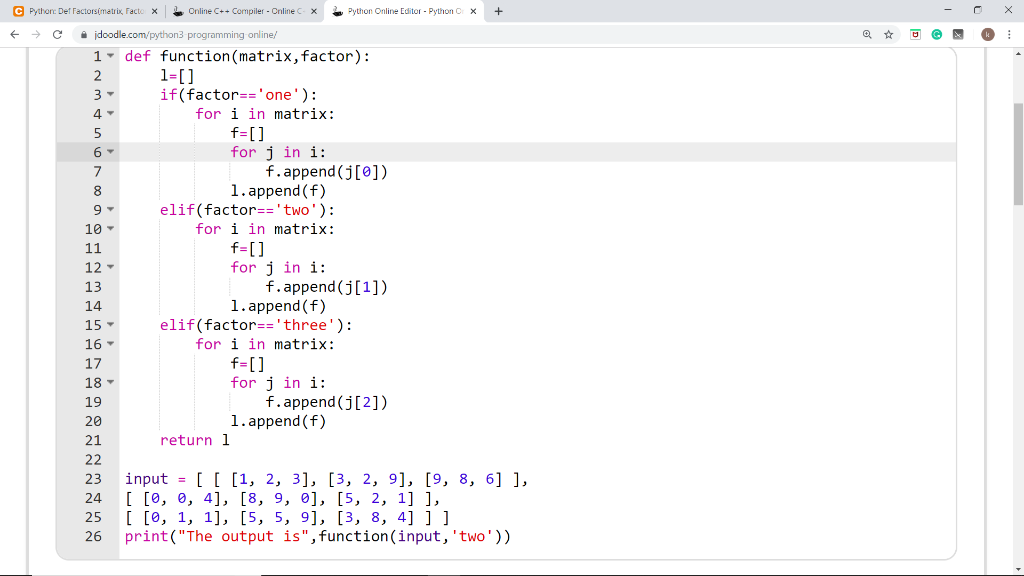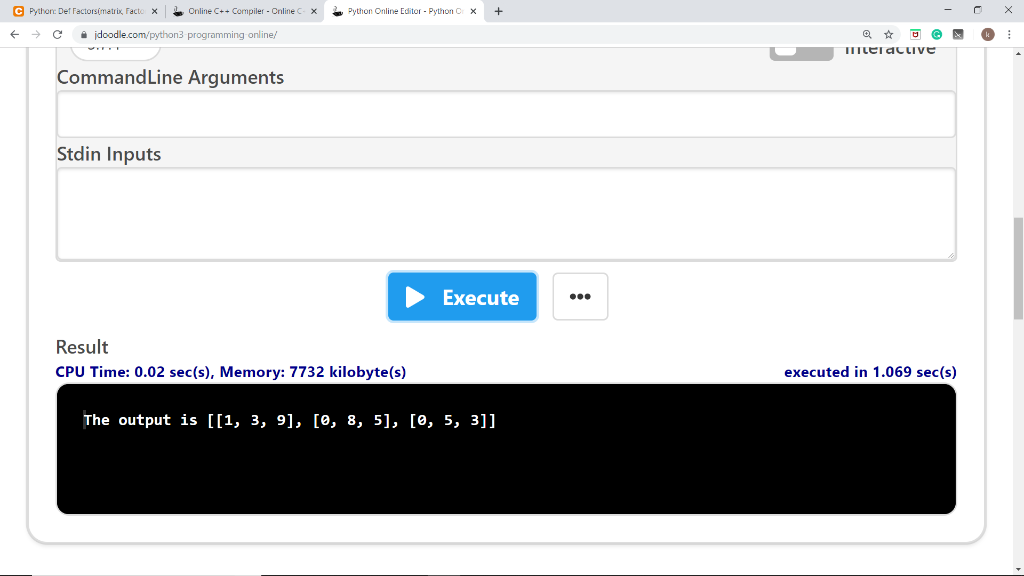Question
In: Computer Science
Python: def factors(matrix, factor): The matrix is a 3D list of integers. factors are either one,...
Python:
def factors(matrix, factor):
The matrix is a 3D list of integers.
factors are either one, two, or three
If the factor is 'one' it will return a the first value from each list
if the factor is 'two' it will return the second value, and same for the third.
Example;
input = [ [ [1, 2, 3], [3, 2, 9], [9, 8, 6] ],
[ [0, 0, 4], [8, 9, 0], [5, 2, 1] ],
[ [0, 1, 1], [5, 5, 9], [3, 8, 4] ] ], 'one')
output = [ [1, 3, 9], [0, 8, 5], [0, 5, 3] ]
Solutions
Expert Solution
The answer to this question is as follows:
The code is as follows:
def function(matrix,factor):
l=[]
if(factor=='one'):
for i in matrix:
f=[]
for j in i:
f.append(j[0])
l.append(f)
elif(factor=='two'):
for i in matrix:
f=[]
for j in i:
f.append(j[1])
l.append(f)
elif(factor=='three'):
for i in matrix:
f=[]
for j in i:
f.append(j[2])
l.append(f)
return l
input = [ [ [1, 2, 3], [3, 2, 9], [9, 8, 6] ],
[ [0, 0, 4], [8, 9, 0], [5, 2, 1] ],
[ [0, 1, 1], [5, 5, 9], [3, 8, 4] ] ]
print("The output is",function(input,'two'))
The input and output is providd in the screenshot below:


Related Solutions
Python program please no def, main, functions Given a list of negative integers, write a Python...
def largest_rectangle_in_matrix(matrix: List[List[int]]) -> int: """ Returns the area of the largest rectangle in <matrix>. The...
from typing import List def longest_chain(submatrix: List[int]) -> int: """ Given a list of integers, return...
Write a Python function that takes a list of integers as a parameter and returns the...
Write a Python function that takes a list of integers as a parameter and returns the...
#Write a program in Python that given a list of positive integers, return another list where...
Python: Write a function that receives a one dimensional array of integers and returns a Python...
USING PYTHON, write a function that takes a list of integers as input and returns a...
Python: How would I write a function using list comprehensions to list of integers into two...
In Python write a function with prototype “def dictsort(d):” which will return a list of key-value...
- The City of St. Louis, Mississippi (population just under 24,000) passed a bond issue for $2,500,000,...
- Suppose the economy is suffering from high rates of unemployment. What kind of fiscal policy should...
- A car accelerates uniformly from rest to 26.5 m/s in 8.60 s along a level stretch...
- Project 4 Prepare a chart of your major expenses and check the impact of inflation by...
- What are the trends in the national minimum wage for the UK? Please answer in an...
- You are in a boat traveling perpendicular to waves in water. The wave speed is 8.40...
- I need to develop an abstract class/ class that will be called RandString will be used...
 venereology answered 1 month ago
venereology answered 1 month ago